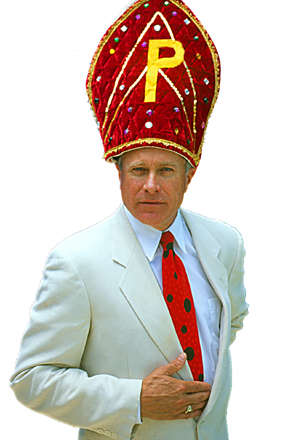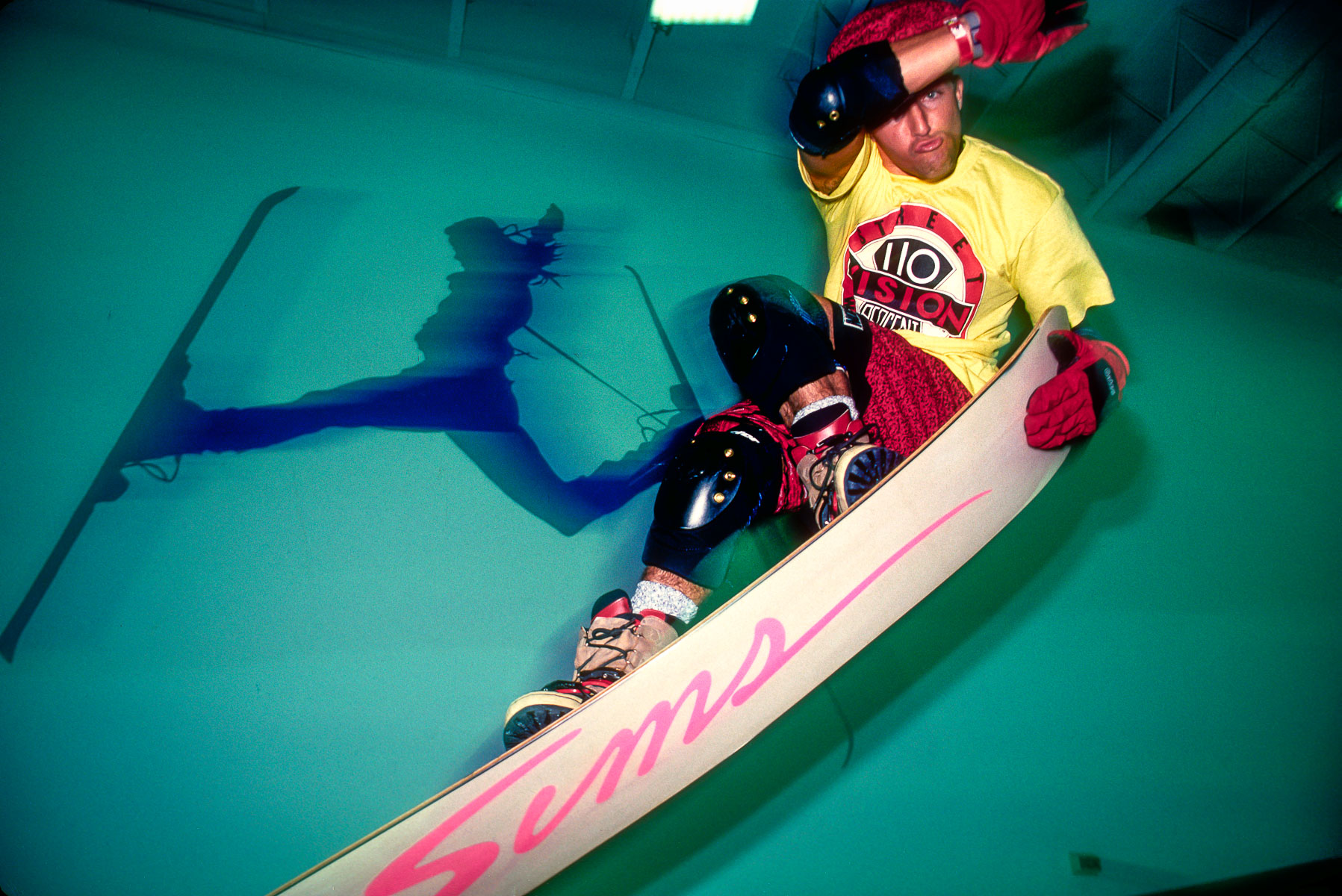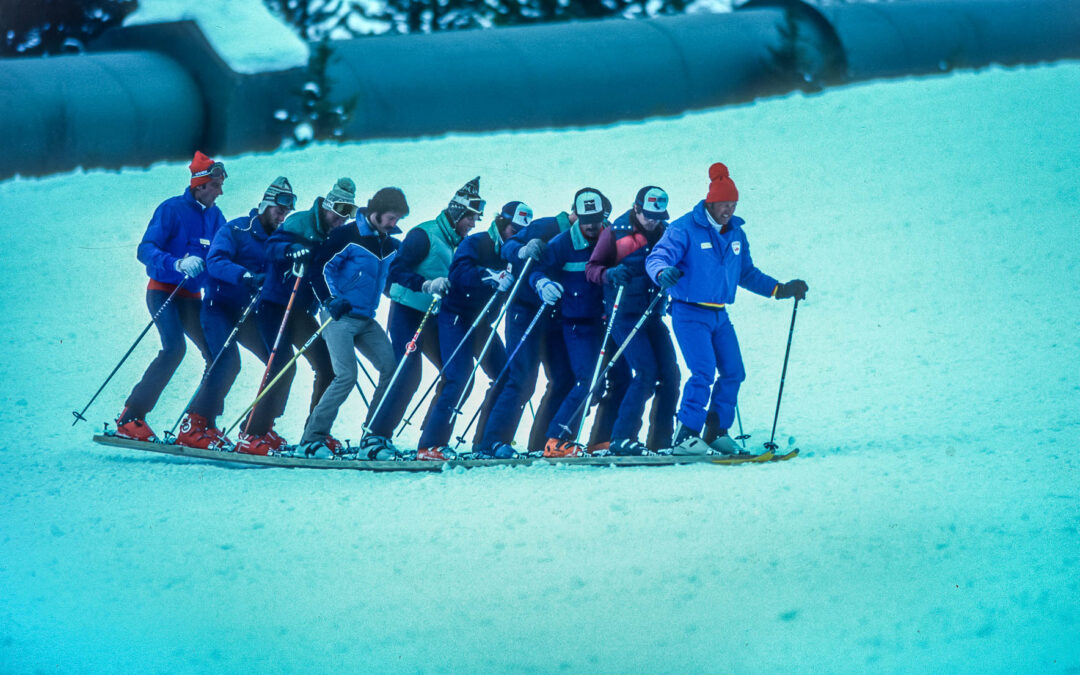
Skis sales took a dramatic dive during the brief period when as many as 10 men would share a single pair, cutting sales by 90%. Snowboarding would soon render them extinct. Photo provided by ski historian Bruce Benedict.
[As I wrapped up an earlier Revelation, I proposed to my beloved readership that they share their list of the top ten reasons U.S. ski sales have shrunk. I elicited only two written responses, so I’ll reproduce both here in their entirety, along with my musings on the subject. Consider these submissions tinder to light a fire under you, Dear Reader, to submit a list of your own.]
From Rick Pasturczak
- Snowboarding-
I’ve noticed most snowboarders are 12 to 20 years old and once they become an adult, almost all stop. While I noticed most skiers continue on. - High school and college sports-
Schools now require practicing sports during Christmas and spring breaks taking away opportunities to hit the slopes and family vacations to the mountains. I’ve been told by many parents the coaches forbid them to ski. - Travel costs-
Lodging, airfare, ground transportation, and lift tickets. - Video games
- Cost of lessons make it expensive to improve.
- Confusing selection of equipment
- Magazines and movies showing extreme skiing
- We need some resorts to be all inclusive.
- Baggy pants. Bring back stretch pants and sex appeal.
- Last, we need mother nature to be more consistent with snow.
From JD Driskell
ONE
It takes too long to learn how to ski and as our society becomes more insistent upon instant gratification, instant news, instant health or instant happiness, to do anything that requires persistence or work ethic to obtain a skill becomes an undesirable pursuit. A strong young athlete can jump off a cliff but can he carve turns once he’s hit the snow? About four years ago I was standing below the Palisades one soft snow day and watched about 30 guys jump, something I will (can?) no longer do, and continued watching as they skied into the bowl at the base and then onto the lower Siberia runs. About 10% of them could make turns, actually carve a turn. Jumping cliffs gets you on YouTube, carving turns gets you… where?
You’ve described the joy of skiing many different ways and the “turn” is what makes skiing skiing. Going straight down is fun but it’s the turn and the float that makes it what it is. Snapping off turns requires strength, timing and lots of practice, lots of days on the mountain. I think people just want to be on YouTube.
TWO
It’s not the cost of the sport. I think most people spend more on hotels and food than they do on tickets, passes or equipment. It’s as if just being in the mountains is enough for them, making a few runs, seeing the scenery and skiing a “black diamond” or “double black diamond” run that makes their day or week. They don’t need to honestly ski it, they just need to get down it. Or, like being seen at a five-star restaurant they just want to be seen on the mountain or be known to have been there through their Facebook posts.
THREE
There’s to many other easier things to do. We, as a society, are too cautious, too scared, too cowardly. We want something safe, like an amusement park ride. No skill required there but there’s still an adrenaline rush.
FOUR
If you haven’t learned how to ski by your late 20’s, you’re never going to do it.

Burt Lamar performing on an indoor ski ramp in Newport Beach, CA, circa 1989. Stunt captured by fellow Sims rider Bruce Benedict.
From Jackson
In my draft of the 1986/87 Salomon marketing plan I estimated the size of the U.S. binding market to be roughly 1.25 million pairs. (We didn’t sell skis then, but as go bindings, so go skis.) I sifted through reams of data to arrive at this figure (which represents sell-in units for both retail and rental channels), so my confidence in this often furry figure is high.
I don’t know what it is now, but I’ll bet the total retail binding market today is roughly what Salomon’s piece was then, around 550,000 units. What the hell happened?
My extremely scientific, totally award-winning speculations as to why the U.S. ski market has imploded despite a growing population of prospective participants are as follows.
- Unless you dumpster dive, the total cost of outfitting a skier is budget-crushing. Most young families can’t possibly afford it.
- The prevalence of high-end demos. For the infrequent user, renting a demo ski makes infinitely more sense than buying. Price-gouging bag fees by airlines that once openly courted skiers made it punitive to bring your own when travelling to distant resorts.
- The cost of a daily ticket, still a major benchmark for the sport’s cost. While the expense of a daily ticket isn’t the only deterrent, the walk-up price of a daily ticket assures no one will try the sport on a whim. (For 2020/21, there won’t be a “walk-up price” as ticket sales will be handled remotely.)
- Small ski areas are by and large gone. They couldn’t afford snow-making, swank amenities or insurance. The localities they served have lost skiers in droves.
- The extinction of public-school ski trips/programs. Programs including the Eskimo Ski Club would put 3,000 kids on the slopes of Winter Park in most winter weeks. Most had no other possible access to wintersports, yet became lifelong skiers. That’s over.
- The fragmentation of the sport. Once upon a time, Alpine skiing was focused on racing and technique. Now it’s only a small corner of a wintersports world divided into many sub-sets, most of which aren’t relatable to the general public. Talent, attention and dollars are spread thin. Snowboarding is but one branch of what had been a single tree.
- The collapse of general sporting goods. Mass merchants and specialty chains used to deliver huge numbers and promote skiing heavily. Gone are Herman’s, Wolfe’s, Gart’s, Cook’s, Sunset, Ski Market, Oshman’s, Sports Authority and Bavarian Village, along with all the equipment they sold.
- Internet sales. Everyone sells direct now. Although many brands fulfill their on-line sales through their established retail network, no one’s territory is secure. Soon a couple of behemoths will virtually dictate the market, replete with their own brick-and-mortar cathedrals, stocked with their own, in-house ski brands.
- Proliferation of small-batch producers, over 100 in the U.S, most selling outside any trackable channel. The overall market hasn’t shrunk as much as have the major brands’ share of it. This has hurt re-investment in the sport and its growth potential.
- The disintegration of the specialty retail channel. There isn’t a major American market that hasn’t lost benchmark specialty retailers in the last 25 years. These shops provided a lot of the connective tissue binding skiers together in their region. By and large, they have not been replaced.
- A disconnect between the sport’s niche heroes and the general public. Formerly, all skiers could relate to the very best because their racing looked like normal skiing, but with gates. Now most of what is on film or TV looks impossible, a euphemism for terrifying.
- Retailer consortiums’ demand for the lowest possible price for a brand’s top-selling models. The supplier margins are so skinny, little is left in the larder to promote the sport on the scale possible in the past.
Even though I’ve exceeded the normal limit for a top-10 list – consider it editor’s privilege – I’m sure my list isn’t comprehensive. I’m confident in this statement because a friend and industry insider has already conveyed a fresh perspective that isn’t evoked in this Revelation. I’m curious if any other of my Dear Readers identify the same drag on the sport’s growth so I won’t reveal his take until I hear from a few more of my flock. My invitation stands: if you send me your list, I’ll post it.
Even if you have no new trendlines to tout, you can always weigh in about which three ill effects belong on the podium.
I look forward to hearing from you.

